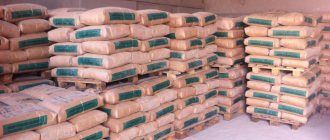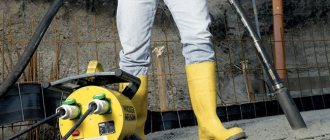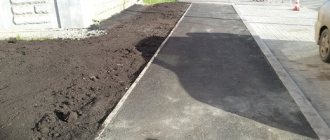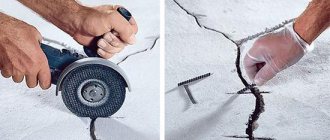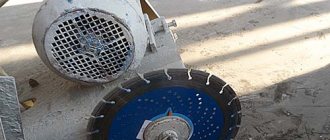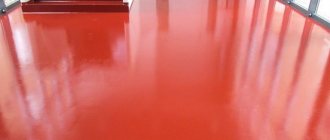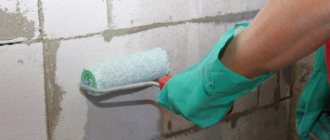Timely painting of outdoor concrete will help protect the durable material from self-destruction. The concrete mixture, when hardened, has a porous structure, so prolonged exposure to a humid environment can be detrimental to reinforced concrete. Structures erected on the street react especially strongly to destructive factors. Special coloring compounds will help protect the structure from destruction, give it an aesthetic appearance and protect it from the negative influence of the environment.
Types of paints for concrete
When choosing a material applied to concrete, climatic and environmental factors must be taken into account. Facade coating products are divided into those that use solvents and those that use water as a base. Also, façade paint may contain various polymer additives that improve their properties and increase the durability of the coating.
Acrylic
Acrylic-based facade paint for exterior concrete work is universal, easy to work with, available in different colors, and allows you to obtain smooth surfaces. It is easy to apply and even those with little experience can paint the walls of a house with high quality. After drying, a durable film is formed on the treated surface, protecting the concrete from environmental influences. Acrylic-based products do not fade, are resistant to abrasion and do not form cracks. Acrylic paint has low air permeability, good weather resistance and optimal adhesion. It can be applied to any porous and rough substrate. It is not suitable if the substrate is wet, because water prevents drying.
Silicate
Silicate paints for exterior use, based on potassium silicate, are a good alternative to traditional water-based paints. Their feature compared to the latter is that they are breathable and water-repellent at the same time. Surfaces coated with them are permeable to steam and impermeable to water, which makes them more resistant to atmospheric influences and more durable. Silicate paint is used both for repairs and for painting new buildings. It can be applied to the walls of buildings located in places with high air humidity, exposed to bad weather, smog. Since it has a high pH, it prevents the formation of mold, mildew, and moss.
Water-based
Water-based paints are undoubtedly the best sellers on the market because they are easy to work with and relatively inexpensive. They consist of polymer components in water, which do not dissolve in it, but are mixed in the smallest parts, forming a suspension. After applying the water-based emulsion to the façade, the water dries and a film forms. Water-based materials can be used for exterior and interior decoration, but before application the surface must be thoroughly primed to avoid the appearance of fungus and mold. The advantages of water emulsion include:
- no pungent odor;
- environmental friendliness;
- ability to pass air;
- fire safety;
- moisture resistance;
- quick drying.
The only drawback is that they are not recommended for painting walls in bright, saturated colors.
Oily
Paint and varnish products based on polymer resins do not contain water; they contain solvents. It has excellent adhesion on concrete surfaces, better than water-based adhesion. Since oil-based materials contain vegetable oils, the likelihood of fungus and mold growth increases. After painting, an elastic film is formed on the surface, which well protects the concrete from atmospheric influences. Since oil paints do not contain water, they can be used to treat concrete at low temperatures. The disadvantages of such paints are considered to be a strong odor, flammability, and a long drying period from 8 to 24 hours.
Advantages of a painted path
Of all the materials that can be used for garden paths, concrete is one of the most attractive. Creating such a path is cheap, fast and practical.
- Among its advantages:
- durability - no need to worry about surface wear;
- environmental friendliness;
- easy to maintain - just wash the path with water and use sealant and wax every few months to refresh the appearance;
- durability - the material is resistant to intense wear, moisture, acids, and sun;
- freedom of design - it can be easily repainted or given any texture.
Concrete can be painted at the stage of creating the path by adding pigment to the solution, or after hardening using various paints. Coloring technology has advanced to such an extent that there are more shades available to choose from than when painting wood.
Smooth concrete can be textured if desired. It can be given the appearance of paving stones, slate, flagstone or even wood. Additionally, you can create joints in the concrete floor to create "blocks", patterns or other texture. Combining a panel pattern with varnish will give the floor a marbled effect.
It is believed that the best painting option is epoxy paint, as it retains its original appearance for longer. However, the needs of each garden path are unique and depend on the climate, humidity levels and desired results - this is what you need to keep in mind when choosing.
Was this article helpful?
Thank you for your opinion!
Write in the comments what questions you have not received an answer to, we will definitely respond!
You can recommend this article to your friends!
Already helped 13 times
What paints are suitable for painting a concrete facade?
There are several types of dyes that are used to coat concrete facades.
These include coatings that meet the requirements for the operation of external cladding materials.
Painting coatings for concrete bases are classified according to their composition:
- acrylic. The composition includes polymers and polyacrylates. A variety is latex cladding. The paints are resistant to moisture, wear-resistant, free of harmful impurities, and elastic. They have poor frost resistance and are quite expensive;
- water-epoxy. They are universal not only for concrete surfaces, but also for others. They have high moisture resistance. It is not recommended to use in places of frequent sun exposure: there is a high probability of weakening the color brightness;
- polymer. They have good wear resistance, withstand both high and low temperatures, and are resistant to aggressive chemical compounds. They have a long drying time and are quite expensive;
- vinyl. They are capable of quite effectively painting a concrete surface with one layer, are varied in color, and are quite wear-resistant;
- acrylic-silicone. They are resistant to the sun, have the positive characteristics of acrylic paints, are durable, and are suitable for outdoor and indoor use.
In addition, for the external coating, paints are used that:
- dissolves in water - contains synthetic resins and is environmentally friendly;
- dissolved by organic solvents - contain flammable substances, vapor-tight, less popular.
In addition to the characteristics of paints, according to the composition and method of preparation, there are materials that have a smooth structure (suitable for a perfectly smooth surface) and textured (for surfaces with minor defects), as well as matte and glossy (differ in the nature of the reflection of sunlight).
How to choose cement
White cement
If you are going to paint a concrete mixture or finished product with your own hands, then you need to pay attention to the choice of cement. The cement must be of high quality.
It is recommended to use white cement to obtain bright shades. The darker the cement, the duller the shade of the concrete will be. Before starting work, it is necessary to pre-mix a small amount of concrete mixture.
It is extremely important to maintain the required proportion of powdered dye, which is added to the composition during mixing. If you add too much of it, it will absorb moisture and the finished product may become cracked. To prevent this from happening, the addition of plasticizers and water-retaining additives is necessary.
What properties should concrete paint have?
Since concrete walls are quite capricious, the requirements for dyes for such surfaces should be increased:
- adhesive properties. Facade paints must have a high penetrating ability for deep adhesion to the surface. To improve these properties of painting materials, it is recommended to prime the surface before painting;
- moisture resistance. Considering the ability of a concrete coating to absorb moisture, manufacturers add special additives to painting materials that can repel water. The higher this ability, the better the paint;
- wear resistance. An important indicator that characterizes the service life of the dye is its abrasion. The more aggressive influences a coloring material can withstand, the higher its endurance rating;
- resistance to solar radiation. Ultraviolet radiation negatively affects the color pigment of the paint: with a low sun resistance, the paint quickly loses its color saturation, brightness and attractiveness, and can peel off. Exterior paints must have high resistance to sunlight;
- vapor permeability. The chemical composition of paints must be designed in such a way as to have the ability to release accumulated moisture. Considering that concrete easily absorbs moisture, if the coating is completely sealed, it will accumulate between the surface and the coating, which will lead to the destruction of the dye and base during temperature fluctuations;
- resistance to pollution. Most paints have good stain resistance: they are not able to absorb dirt and are easy to clean. The smoother the painted surface, the less susceptible it will be to the accumulation of dust and dirt;
- drying time. Drying the outer paint material as quickly as possible ensures the least chance of exposure to rain; the faster the paint dries, the better;
- consumption per 1m2. Concrete requires a large consumption of dye, so you should start from the characteristics of the chosen paint;
- saturation. The indicator is directly related to consumption: the higher the saturation, the lower the consumption. The concrete base requires complete painting, since the gray reflections of the coating are not aesthetically pleasing and unattractive.
NOTE!
Due to the increase in strength and wear resistance, exterior paints may contain some elements harmful to health.
In this regard, it should be borne in mind that such paints are not suitable for indoor use.
Is it possible to paint aerated concrete blocks without plaster?
Aerated block is a building material that requires mandatory finishing. This is due to the high hygroscopicity of cellular concrete. Therefore, finishing for aerated block walls must meet three basic requirements:
- prevent street moisture from penetrating into the concrete structure;
- provide the necessary vapor permeability so that the walls “breathe”;
- ensure normal operation of the building.
Facade plaster fully meets these requirements. Aerated concrete paint for exterior use is applied on top of the plaster layer, which gives the wall the desired color and texture. Is it possible to paint aerated concrete without plaster? It is possible if the selected paint for aerated concrete meets the specified requirements, that is, it forms a vapor-permeable, moisture-resistant layer on the surface. Not all paints and varnishes have such properties. So how to paint aerated concrete blocks on the outside without plaster, and what paint should you use to plaster the walls? Let's look at different types of paints in more detail.
Painting concrete facades
To successfully paint a concrete facade, it must be properly prepared, the most suitable one must be selected, and the time required for drying must be maintained.
- Clean the concrete from old paint, dirt, and plaque. If there is mold, moss, or fungi on the surface, they must be removed.
- Seal all cracks, holes, and uneven areas, as moisture can accumulate there under the paint layer, which as a result will begin to peel off and move away from the concrete. The surface should be as smooth and even as possible.
- Begin work when weather conditions are favorable. It's best to have 2-3 days in a row without rain before you start painting.
- To ensure a high-quality coating, it is recommended to apply a layer of primer. This is especially true if the paint is applied over an old layer that is different in color from the new one.
- In the process of painting the facade, scaffolding or ladders, rollers, gloves, and buckets will be useful. It is better to prepare these materials in advance so that everything is at hand during work.
- Calculate the area that needs to be painted. Then multiply the resulting number by the average consumption of facade paint (it is indicated on the labels). And multiply the resulting figure by two. Typically several coats are required.
After preparing the concrete, you can begin painting. You should start from a corner or from the top if you are painting a wall. The color is distributed slowly and evenly over the entire surface. Each subsequent layer is applied after the previous one has dried.
It is not recommended to paint freshly plastered facades, as the plaster must “ripen”, usually this happens no earlier than after 28 days. Exterior paints are the best way to improve the appearance of your home and give it a finished, beautiful look.
Polyurethane enamel - instructions
The instructions suggest painting surfaces with enamel at temperatures up to +5C. When starting painting, you need to mix one paint ingredient, then add another and mix again. Then you can paint the surfaces.
It is proposed to paint the floor twice - the first time with a thin layer and then repeat the painting a day later. The paint takes two days to two weeks to dry. After two days you can walk on the floor, the paint will not stick. After seven days the layer becomes mechanically resistant, after two weeks it becomes chemically resistant and suitable for work.
Features of concrete surface
Concrete is one of the oldest building materials. Previously, the material consisted of sand and lime, now its main component is cement.
The concrete surface has a rather boring and gray appearance; most often it is refined with various facing materials.
The concrete base has increased porosity and roughness, is capable of absorbing a lot of moisture and retaining it in the surface layer, so to protect it requires paint that has good adhesion to the surface.
Despite the fact that the concrete surface requires additional finishing, the material is very strong, stable and durable.
Protection materials
To prepare the surface, specialists use impregnating agents. There are different materials on the market, but they all perform the same function - they save concrete from liquid penetration. Hydrophobization helps to protect building materials. Such work can be carried out independently, without the help of a professional. This method has disadvantages. The main one is that, despite the decrease in surface wetting, the pores of the building material remain open.
The creation of a waterproof film has a number of features. For example, a disadvantage of the method is considered to be poor vapor permeability of the mixtures used during the work. In addition, protective coatings degrade over time and must be reapplied periodically. However, you can slightly improve and prolong the effect by combining the impregnating composition and film. But this should be done on the basis of the same components. In addition, you can use silicone varnishes and acrylates.
Return to contents
Polysilicate and silicate paints
Silicate paints are quite resistant to moisture compared to lime paints, but have almost identical good vapor permeability. They are highly durable, resistant to mold and the harmful effects of atmospheric factors. Silicate paints are very resistant to contamination; the coating does not electrify. There is a fairly limited range of colors available for sale.
Silicate paints repel water
Polysilicate paints are a modern innovative type of silicate paints, formed by enriching them with various resins. Such paints are much easier to apply. They have excellent water resistance, high vapor permeability and, unlike their predecessors, are compatible with organic plaster.
Building facade painted with silicate paints
Consumption of polysilicate paint is 140-150 g/m².
Silicate facade paint Ceresit CT 54
Preparing a concrete floor for painting
Preparatory work for painting a concrete floor is carried out as standard: they begin with cleaning. Garbage and dust are completely removed, all contaminants are removed - oil stains, fuels and lubricants, etc., and at the same time an audit of the condition of the concrete base of the top layer is carried out. Repairing cracks, potholes and other defects in the upper layers of concrete is necessary. To cut or knock down protruding sections of concrete, a grinder is used, and cracks and cavities are sealed with special repair compounds, putties or cement-adhesive mortars. All repair seals are thoroughly dried using fan heaters and similar equipment during the cold season.
But it is recommended to paint concrete floors under normal temperature and humidity conditions, and pay attention to the manufacturer’s recommendations. All paint compounds (with the exception of epoxy) are applied to completely dry surfaces
If a previously painted concrete floor is being repaired, then all the paint layers are peeled off down to the concrete, and then the surface is dusted extremely thoroughly; it is also possible to use a household vacuum cleaner, but it is quite powerful
Removing old paint is very important - with this simple process, the porous, capillary concrete structure of the top layer is opened so that the new penetrating and strengthening composition fulfills its task - strengthening and leveling the surface, making the base monolithic
Much in the work depends on the type and quality of the chosen paint for concrete, and if the manufacturer’s recommendations include a clause about preliminary priming before painting, then it is unwise to ignore this simple advice. Prime cleaned and prepared surfaces with rollers, corners, junctions and other difficult areas with brushes. Before painting the floors, the primer must be completely dry. Some types of primers are applied in two layers, with the obligatory drying of each.
Painting compositions are prepared according to the instructions for them, which the responsible manufacturer always indicates directly on the paint packaging. Water-soluble paints should not be too thick; their working consistency is adjusted by diluting with water or the specified solvents. You need to be especially strict when preparing a two-component composition - any deviation from the regulations can be fatal for future finishing. The proportions given by the paint manufacturer must be strictly observed. The lifespan of different compositions is different; there are paints for which this time is very short - compositions with liquid glass and some epoxy compositions. The batch is made according to calculations, the number of workers and the convenience of applying paint, the presence of cramped conditions, and air temperature. Mixing two-component compositions is quite standard - pour one component into the other and mix thoroughly with a construction mixer or a drill with an attachment at low speeds. Some compositions, especially in small volumes, can be easily mixed until smooth with a simple device in the form of a wooden slats or any household tool.
Lane markings
Garden paths begin to be built with markings. First of all, you need to determine their future shape.
Next, you need to drive stakes along the perimeter of the paths. A cord should be pulled between the stakes. The number of stakes used depends on the number of bends in the path.
Dyes for brickwork
The masonry mortar can also be given the desired color, which is achieved by introducing pigments. There are many dyes for masonry on sale - Precolor, YIPIN, Perel, Fepren and others. Shades of the same color vary greatly from one manufacturer to another, so you should choose them according to your individual needs. It is extremely undesirable to use pigments of different brands on the same masonry - this can spoil the overall appearance of the building, because the color of the seams will not be the same.
Types of dyes for brickwork mortar
All described types of pigments, as well as dyes created on their basis - acrylic, acid and others, are suitable for this purpose. They color lime, cement, cement-lime mortars. The proportion of paint in the total mass should not exceed 8%, otherwise the strength of the brickwork will decrease.
Choice - what to look for
The most important indicator is the color of the pigment. With its help, you can highlight the seams or, on the contrary, make them invisible (if you use dye to match the brick). The pigment should strengthen the structure and make the solution more resistant to the sun, water, and temperature changes.
Also, when selecting dyes, their moisture retention rate is taken into account:
- low – 5-6% (for clinker bricks);
- average – 7-10% (for facing bricks);
- high – 10-15% (for sand-lime brick).
Taking into account such parameters, it is possible to reduce the risk of pigment discoloration and the appearance of efflorescence spots on the surface of the seams. Most often, shades of pigments such as brown, yellow, pink, beige, and white are used for brickwork. Although you can use any other color.
Preparation and use of the solution
To make lime mortar, mix 1 part fine lime, 2 parts sand and a sufficient amount of water. The cement-lime mortar includes cement and lime milk, as well as sand (1 part each of lime, cement and 4-6 parts of sand).
First, mix the dry ingredients, then pour in water so that the consistency is like soft butter (the amount of water can be determined by eye). Afterwards, pigment or liquid dye is added to the prepared masonry solution. It is better to use a concrete mixer for mixing. A small volume of components can be mixed manually, using a spatula, in a bucket or other container.
The classic color is white; it is obtained by adding slaked lime, zinc oxide or titanium oxide. The last option is the most expensive, but it ensures longevity of the shade for decades. To reduce costs, the entire masonry is often filled with ordinary, gray mortar, and colored mortar is placed only along the edges that will be visible.
Innovations in the use of colored masonry mortars
Manipulating the color of brickwork or individual walls or sections of the wall will help create unusual housing design options. A universal way to highlight masonry is to use contrasting shades. White seams will look especially bright in combination with any brick tone except yellow.
Also, colored solutions can mask masonry seams and completely hide the structure of the wall. To do this, pigments are added to give the solution an absolute similarity to the tone of the brick itself. When cleaning the seams, they are well aligned so that they follow the texture of the base material. You can, on the contrary, not give the wall a monolithic appearance, but make an extruded pattern. To do this, blocks of bricks are laid in a special way.
Experts also use the following new techniques to create spectacular brickwork:
- adding finely ground glass fluorescent powder to the solution to glow the seams against the background of dark brick;
- introduction of pigments that change color depending on the ambient temperature.
When choosing dyes, you need to ensure their suitability for the purpose of tinting the solution. Unscrupulous manufacturers replace non-ferrous metal salts with aniline dyes, which wash out and fade literally within a season. Only real pigments will provide a beautiful appearance to buildings and will serve for a long time - do not skimp on quality!
Acrylic paints
Acrylic paint has very good adhesion to the base, elasticity, resistance to dirt and water washing. It boasts low permeability, is suitable for restoring an old façade, it can also be used to paint mineral substrates, and to lay it on previously painted layers of cement and cement-lime plaster. It should not be used on silicate or lime plastered surfaces.
Acrylic paint consumption - 110-135 g/m².
Acrylic facade paints
Paints based on acrylate and vinyl, as well as those based on silicone resins, can be either water-soluble or solvent-soluble
How to paint aerated concrete blocks?
To choose the right paint for aerated concrete, we offer a simple algorithm:
- Will aerated concrete be coated with plaster before painting? Silicate
Types of paint for plaster Types of paint for “bare” gas block - Vinyl
- Water-epoxy
- Polymer
- Water soluble
- Acrylic
- Oily
- How will you apply the paint? It is not recommended to apply paints with toxic properties yourself. To work with such materials, you need special protective equipment and equipment (spray guns, sprayers). Safe water-based paints can be applied yourself using regular painting tools. Water-epoxyOil
Toxic paints Non-toxic paints - Silicate
- Water soluble
- Acrylic
- Vinyl
- Polymer
- How often do you plan to repaint your house? Painted aerated concrete needs to be repainted every 1-2 years if oil and vinyl paints are used. Color fastness up to 3-5 years is ensured by acrylic, water-soluble compositions. Silicate and polymer coatings last significantly longer (5-7 years). The leader in durability is epoxy paint, which requires renewal no earlier than after 10 years.
Expert opinion Vitaly Kudryashov builder, aspiring author
Ask a Question
When choosing what to paint aerated concrete on the outside, you also need to take into account the air temperature (not all paints and varnishes can be used at temperatures below +10°C), consumption and cost of painting 1 m², and drying time.
Useful video
How to paint concrete outside in video tips:
2017-06-27
Concrete, despite its resistance to mechanical loads, has a porous structure. This feature is manifested in the fact that its texture can quickly collapse under the influence of some negative factors. Peeling of the outer layer or dusting occurs. Negative consequences can be prevented or minimized by using external protective coatings, one of which is concrete paint.
Often such coating is used to increase the service life of buildings. A certain layer is applied to the facades, which blocks the interaction of the building material with external factors. The moisture-resistant structure becomes a barrier to biological or chemical influences from the outside. Exterior paint is important not only when applying it to buildings, but also when painting various concrete structures or bridge supports made of this material.
Safety precautions
As when performing any work, simple safety rules should be followed. The coating must be done in special clothing, protecting your hands and face from paint, acids and other solutions.
You also need to remember a few simple tips:
- Use a respirator when removing old paint. In the past, lead-containing paints were often used; their dust is harmful to health.
- Collect waste during processing in a closed container.
- For work, use a mixture with a valid expiration date.
- Store the remaining paint after finishing the work tightly closed in a room with a temperature not lower than +12°C.
- If paint gets on your skin, be sure to wash it off with a cotton pad soaked in solvent or sunflower oil.
